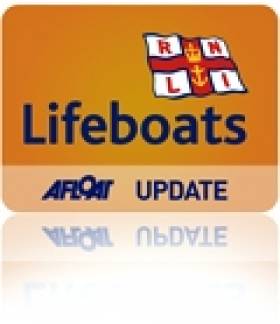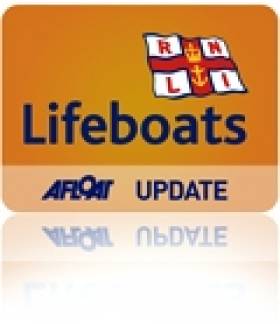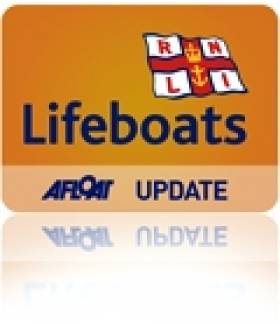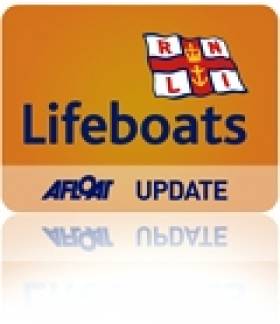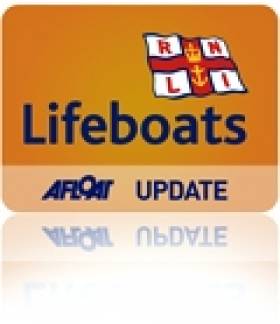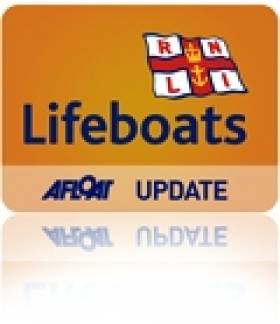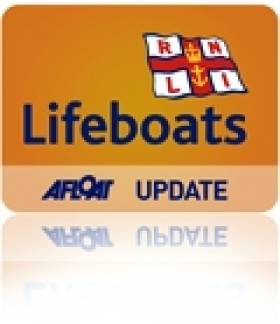Displaying items by tag: Lifeboats
Portaferry Lifeboat Assists Family On Stranded Yacht
#RNLI - Portaferry RNLI received a request to launch their inshore lifeboat at 10.40am this morning (22 July) to the aid of a family on board a stranded yacht.
The lifeboat launched at 10.47am and arrived at the scene just south of Dogtail Point in Strangford Lough, Co Down seven minutes later.
The 13m yacht had run onto rocks where it remained stranded with the two adults and two children onboard until the help arrived.
Weather conditions at the time were very foggy with poor visibility, a Force 2 southerly breeze and calm seas.
When the volunteer crew from Portaferry RNLI arrived, they were assisted by the crew of a local boat, the Cuan Rib, in easing the stranded yacht on board clear of the rocks.
The volunteer lifeboat crew then inspected the yacht for damage at the scene before escorting the vessel and its passengers safely back to Portaferry Marina.
Newlyweds' Surprise Gift To Crosshaven Lifeboat
#RNLI - In a first for Crosshaven RNLI, the volunteer crew welcomed newly married couple Kieran Geasley and Patricia Lenihan to the Cork Harbour lifeboat station.
Geasley, a commercial fishing skipper from Cobh and a former RNLI volunteer at Dunmore East, and Lenihan, from Carrigaline, wanted to make a donation to the RNLI instead of putting wedding favours on the tables at their reception.
Lifeboat helm Kieran Coniry, along with fellow crew Ian O’Keefe and Catherine Levis, welcomed the couple to the station with the traditional bottle of champagne and thanked them on behalf of the RNLI for their generous donation, wishing them a lifetime of happiness together.
In other recent lifeboat news, Rosslare Harbour RNLI volunteers launched their all-weather lifeboat on Friday evening (18 July) to go to the aid of an 8m yacht with a broken rudder.
The yacht was bound for the south coast and was about 1.5 miles north of Rosslare Harbour. Visibility at the time was poor due to sea fog and the wind was a south-easterly Force 3 to 4.
The yacht, which was crewed by a father and his young son, was taken under tow by the lifeboat into the safety of Rosslare Europort.
Howth, Wicklow Lifeboats Aid Vessels With Engine Troubles
#RNLI - Howth RNLI continued a busy week of callouts on Wednesday evening (16 July) when the volunteer crew launched to assist a 27ft motorboat with no power drifting in the vicinity of the Nose of Howth.
The crew was alerted at 6.43pm following a distress call that a motorboat with two crew members aboard was drifting with no engine power at the mercy of the strong tide.
Weather conditions at the time were very good, with a light westerly Force 2 to 3 breeze and good visibility.
The Howth lifeboat, under coxswain Fred Connolly and with five other crew members on board, quickly located the casualty vessel and established a tow line to return the vessel and its occupants to the safety of Howth Harbour exactly an hour after the initial alert.
"The crew of the motorboat did the correct thing to call for help as soon as their vessel experienced engine trouble," said Connolly. "We are pleased that we were able to locate and tow the vessel to safety before it drifted closer to the shore."
Later that evening, Wicklow RNLI launched its all-weather lifeboat Annie Blaker to go to the aid of a 24ft yacht with mechanical problems off the Wicklow Coast.
The alarm was raised after the boat on passage south developed engine problems, With light wind, the yacht was unable to make any headway under sail, so the crew dropped anchor and contacted the Irish Coast Guard for assistance.
Wicklow's lifeboat, under the command of coxswain Nick Keogh, located the yacht – with two adults and a dog on board – one mile east of the Six Mile Point at 11.54pm. Conditions in the area were calm sea and light wind.
Crew member Kevin Rahill was transferred onto the yacht to establish a towline and assist the two sailors. Once the towline was rigged, the yacht was towed back to Wicklow Harbour, where it was safely secured alongside the East Pier by 1am.
Bundoran Lifeboat Helps Six Teenagers Trapped By Tide
#RNLI - Last night (17 July) the volunteer crew of the Bundoran RNLI lifeboat were paged by Malin Head Coast Guard to the aid of six teenagers who had been cut off by the tide at the West End of the Co Donegal town.
Bundoran's lifeboat William Henry Liddington launched just after 8.30pm with four crew on board and were on the scene within two minutes to find the group, who had climbed down to the water’s edge but were unable to make their way back and became trapped by the tide.
The six, none of whom were injured, were helped on board by the lifeboat crew and brought safely back to the station, where they thanked the crew.
Helming the lifeboat on the callout was Dessie Daly, who said: "This was another callout that had a happy ending.
"We thank the member of the public who made the initial emergency call and remind anyone who sees anyone in danger on the coast to call 999 or 112 and don’t assume that somebody else has done it."
#RNLI - Portaferry RNLI launched its inshore lifeboat yesterday afternoon (14 July) to the aid of a man who had suffered a head injury in one of the races during Portaferry Sailing Club’s annual regatta.
The lifeboat launched at 2.36pm and met up with the injured man a few minutes later on board his 12m yacht just off Marfield Bay in Strangford Lough, Co Down.
Weather conditions at the time were cloudy with good visibility, with a Force 2 to 3 southerly wind and calm seas.
After assessing the injured man’s condition, the volunteer crew transferred him into the lifeboat before taking him to Strangford Harbour, where he was then passed into the care of the Northern Ireland Ambulance Service.
Around the same time, RNLI Bangor was launching to investigate reports that children could have been on board an abandoned homemade raft spotted adrift off Ballymacormick Point on the edge of Belfast Lough.
Calm seas and fine weather allowed the lifeboat to proceed at full speed to the search area between Ballymacormick Point and Orlock Point.
After an extensive two-hour search of the area in conjunction with a fishing vessel and a coastguard rescue team, nothing was found.
The search was later terminated when enquiries found that there was a high probability that the raft had drifted from shore during high water.
Michael McKenna, volunteer RNLI helmsman who was involved in the search, took the opportunity to remind all children playing along the coast of the SAFE code: S for spot the dangers, A for always go with a friend, F for find and follow the safety signs and flags and E for Emergency - put up your hand and shout or ring 999/112 and ask for the coastguard.
It was the third callout for Bangor RNLI in three days, after a busy Saturday 12 July that began with a morning request from Belfast Coastguard to assist in the search for an inflatable dinghy.
The dinghy had been spotted by a concerned member of the public at the mouth of Larne Lough. The Bangor volunteer crew joined the Larne RNLI lifeboat in the search for the dinghy and its occupants. The former were quickly on scene and found the dinghy deserted with its engine down and a rope around the propeller.
The name painted on the dinghy hull was passed to Belfast Coastguard who were able to contact the owners. Thankfully, the owners reported that the dinghy had broken free from their vessel and that no one was on board.
The second call of the day came at 11:55am when the Bangor lifeboat launched to rescue four people from a motor boat that had broken down off the oil jetty at Cloghan Point, on the northern shores of Belfast Lough.
On scene, the RNLI crew quickly evaluated the situation and manoeuvred the lifeboat close to the broken-down vessel.
With relatively calm weather conditions, a tow rope was rigged and successfully passed to the motor boat, which was then towed the four miles back to the safety of Bangor Marina.
"Engine failure close to shore could lead to a life-threatening situation," said Bangor RNLI volunteer helmsman Iain Dobie.
"We always urge everyone going to sea to make sure their electrical systems and engine are well maintained and in good working order. A good anchor and chain should always be carried as part of essential safety equipment.
"We are glad the family on board this vessel are now safely ashore," he added.
Busy Three Days For Dublin Lifeboats In Howth & Skerries
#RNLI - Howth RNLI rescued a party of tourists yesterday afternoon (Monday 14 July) after the passenger boat they were on got into difficulty on the north side of Ireland’s Eye.
The volunteer lifeboat crew was alerted at 3.25pm following a Mayday call that a 30ft passenger boat had ran aground onto rocks and was taking on water.
Weather conditions at the time were described as good, with a westerly Force 2 to 3 wind blowing.
The lifeboat, under coxswain Fred Connolly and with four crew members on board, made its way to the scene a mile and a half away from Howth Harbour.
On arrival at the scene, Howth RNLI observed that another boat had come to the assistance of the casualty vessel and was holding it in position ready for the lifeboat to come alongside. It then emerged that the stricken vessel was not taking on water.
The lifeboat crew proceeded to transfer all of the tourists from the passenger boat safely onto the lifeboat, before establishing a tow line and returning the vessel and its occupants safely to Howth Harbour with no medical assistance required.
Further north in Co Dublin, Skerries RNLI were even busier in the weekend days before, responding to two separate callouts to vessels in difficulty.
Shortly before 5.30pm on Friday (11 July) the volunteer crew launched their Atlantic 85 lifeboat Louis Simson following reports of a small motor craft broken down off Donabate beach.
The lifeboat, with David Knight at the helm and crewed by Rob Morgan, Joe May and Eoin Grimes, proceeded directly to the area where they quickly located the motor craft with two people on board.
Conditions on scene were calm with a Force 2 southerly wind. A tow was established and the vessel was brought safely to Howth.
The second callout came shortly before 10.30am on Saturday (12 July) when Dublin Coast Guard requested Skerries RNLI launch to assist a yacht that had fouled its propeller North of St Patrick's Island off Skerries.
The lifeboat launched with David Knight on helm and Conor Walsh, Rob Morgan and Stephen Crowley also on board. There was a Force 1 northerly breeze at the time of launch and visibility was slightly reduced due to a misty rain.
The lifeboat quickly located the 13m yacht, which had fouled its propeller on a lobster pot. The volunteer crew managed to free the yacht and tow them safely to Skerries Harbour, where they then freed the remaining obstruction from the propeller.
Skerries RNLI's third launch of the weekend was less urgent but no less important, as the volunteer crew carried out their regular training exercises on Sunday morning (13 July).
Speaking of the callouts, Skerries RNLI volunteer lifeboat press officer Gerry Canning said: "It was a busy weekend but our volunteers are always ready and willing to drop whatever they are doing to help anyone that is in difficulty at sea."
#RNLI - Lough Ree RNLI aided 10 people in two separate callouts over the weekend.
The first call came just before 7pm on Saturday (12 July) following a report that two craft vessels had ran aground on the east shore of Inch McDermott. The volunteer crew launched their inshore lifeboat within minutes at 7.06pm.
At the scene, the crew discovered that a 30ft cruiser with two adults on board has suffered engine problems and had drifted ashore.
Meanwhile, a passing 80ft barge with four adults on board that had attempted to give assistance went aground herself.
The lifeboat eased the cruiser off the rocks and gave her into the care of a passing cruiser that had stopped to provide any assistance, before towing the barge back into deeper water.
Thankfully the barge had not suffered any damage and was able to tow the cruiser to Ballyleague. The lifeboat crew extended thanks to the crew of the cruiser Enchantress for their assistance.
The lifeboat crew was called upon for a second time at 4.42pm on Sunday afternoon (13 July) when a cruiser ran aground in the same area.
On scene a 33ft cruiser had grounded with four adults on board. The craft was eased back into deeper water and, after checking for damage, she was able to proceed on her journey.
#RNLI - Arklow RNLI’s volunteers gave the World Cup final the boot last night (Sunday 13 July) to respond to a pleasure craft in difficulty with three people on board.
Most of the lifeboat crew were settling down to watch the game at 8pm when the pager alert came in. The crew dropped what they were doing and made straight for the lifeboat station.
Within minutes of the alert, the all-weather lifeboat Ger Tigchlearr was en route to the distressed vessel, which was a short distance from the Roadstone Jetty, south of Arklow Harbour.
Once on scene it was established that the pleasure craft was taking on water and the three crew members were evacuated to the lifeboat.
A tow line was set up and the small pleasure craft was towed back to Arklow lifeboat station, where the volunteers brought the vessel safely up on to the inner slipway.
The three crew of the stricken pleasure craft were brought ashore safely at the lifeboat station.
Following the shout, Arklow RNLI deputy launching authority Declan Smullen gave "thanks to all of our volunteers who drop everything in their personal lives when the pagers sound and go to sea in all weathers, 24/7, to save lives at sea."
Arranmore Lifeboat Rescues Two From Drifting Punt
#RNLI - Following last week's assisting of nine people in two separate yacht breakdown incidents, Arranmore RNLI were out again yesterday (10 July) to rescue a man and a woman from a 14ft punt off the Donegal coast.
The volunteer crew launched their lifeboat at 4.30pm following a report from Malin Head Coast Guard that the fibreglass punt had suffered a broken outboard engine and broken oar in the Crohy Head area.
The all-weather lifeboat, under coxswain Anton Kavanagh and with six crew on board, made its way to the scene at Trawenagh Bay, six miles out of Arranmore.
Irish Coast Guard helicopter Rescue 118 was also tasked to the scene, and spotted the casualty vessel shortly after 5pm at the mouth of Trawenagh Bay.
Weather conditions at the time were good, with a calm sea and clear visibility.
At the scene the lifeboat crew transferred the punt's two passengers onto the safety of the lifeboat before returning them to shore.
Using the station's Y-class lifeboat, the crew towed the stricken punt to safety at Black Point slipway between Trawenagh and Crohy.
Speaking following the callout, Kavanagh said: "This was a joint operation between ourselves and the coastguard and we were happy to be able to return the two people safe and well back to Black Point slipway this evening."
#RNLI - On 14 July our friends across the Irish Sea at Blackpool RNLI will celebrate 150 years of lifesaving.
The station was established in 1864 – 40 years after the RNLI was founded – and has been operated by a large team of dedicated volunteers ever since.
During its 150-year history, the charity’s lifeboats in Blackpool have launched on 1,898 occasions and have rescued 625 people.
A great deal has changed for the station in that time. The first lifeboat station to be built in Blackpool cost £170 – in sharp contrast to today’s station running costs, which total £85,000 per year.
The cost of RNLI lifeboats has also changed dramatically. Samuel Fletcher of Manchester, the station’s second lifeboat, entered service in 1885 at a cost of just £398. This sum is considerably smaller than the £214,000 price tag of the current Atlantic 85 William & Eleanor.
Running costs are not the only thing that has changed in the 150 years since Blackpool RNLI was established. The number of calls for help has also changed significantly.
In the first 100 years of service Blackpool’s RNLI volunteers had an average of just two service calls per year. However, for over a decade now the station's volunteers have launched on average 64 times each year.
On some occasions callouts are straightforward and simple but on others the rescue operations are challenging, dangerous and demand extraordinary levels of seamanship, skill and bravery.
During Blackpool RNLI’s 150 years of saving lives at sea, the charity’s volunteers have been awarded six medals for gallantry, three silver and three bronze.
The most recent medals for gallantry were awarded to Keith Horrocks MBE and Phil Denham in 1988, awarded in recognition of the courage, skill and determination they displayed when both inshore lifeboats were involved in the rescue of two people in very confused seas.
Blackpool RNLI volunteer lifeboat operations manager Keith Horrocks MBE said: "Our RNLI lifeboat station in Blackpool has a very long and proud history of saving lives at sea.
"Our 150th anniversary is a significant milestone and provides a timely opportunity to remember the hundreds of men and women who have volunteered for the RNLI in Blackpool since 1864.
"Many things have changed for the charity since 1864 but the dedication and enthusiasm of our volunteers has not."



























